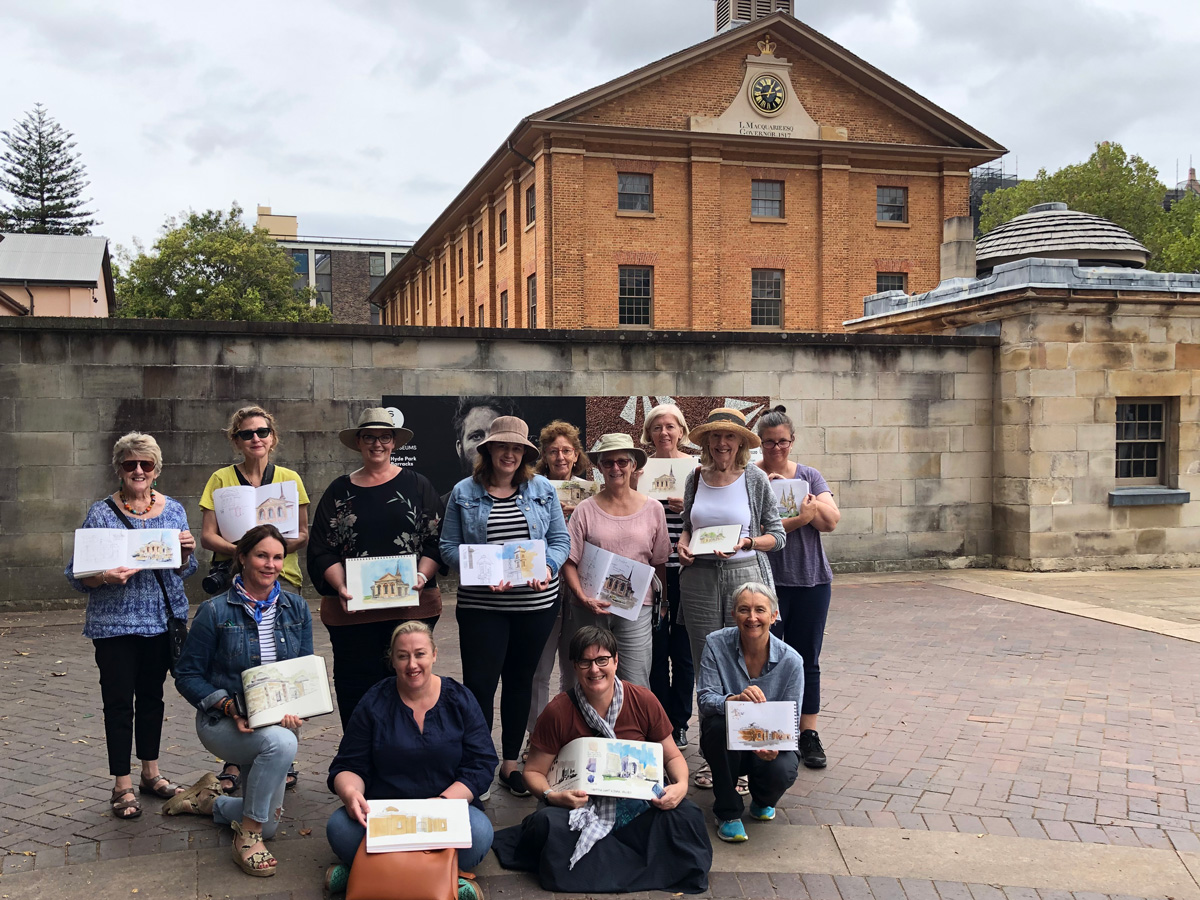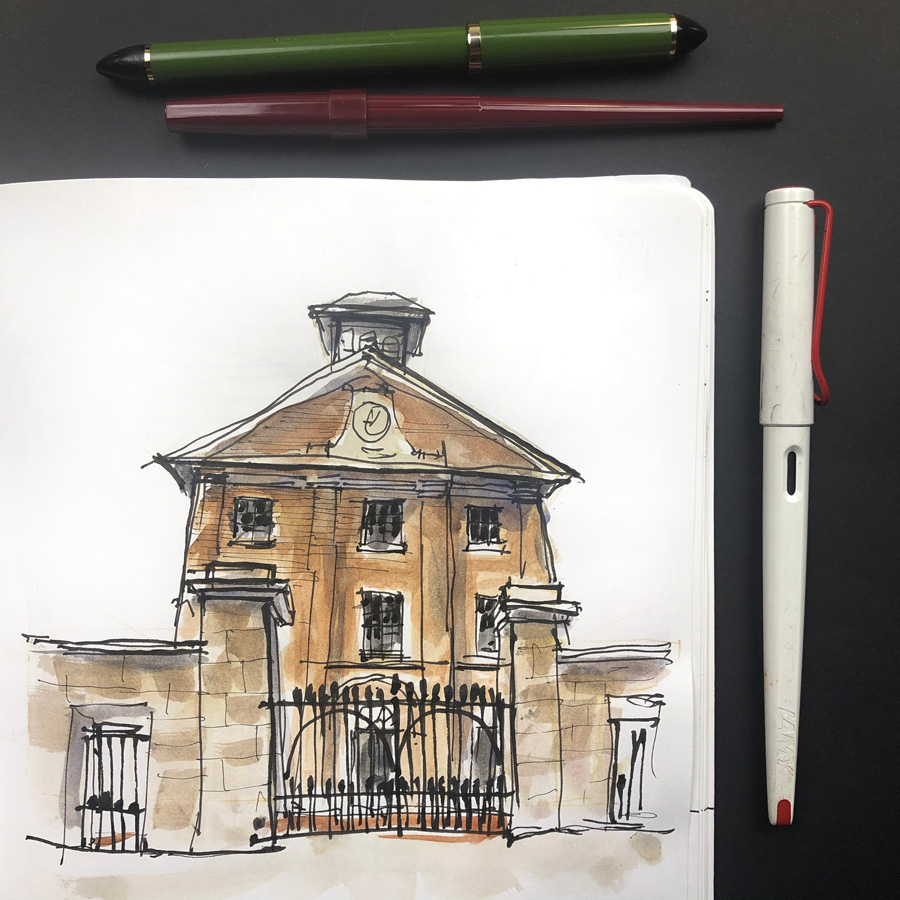
Last week I ran a 3 day Buildings In Watercolour workshop. It’s the first time I have offered a local workshop over 3 days and it was really great to expand my usual 2 day Sketching Architecture programme so that I could include more about watercolour and have a few more different locations to sketch.
I’m so thankful for three days of lovely weather as we’ve had a lot of rain lately. I always have wet weather options and can still teach my content from sheltered locations, but it is so much better to be outside sketching.

We had a wonderful group from all over – Adelaide, Melbourne, Canberra, Port Stephens, New Zealand (Wellington and Auckland), Vancouver, New York City and a few from Sydney! It’s amazing how many people travel for my local workshops these days. Wow!

Buildings in Watercolour: Concepts and Locations
The workshop sessions covered a range of concepts and techniques including:
– sketching in edges, shapes and volumes,
– adding thickness and depths,
– looking for leading edges,
– simple watery and juicy watercolour washes,
– doing value studies and getting lively shadow washes,
– doing measured drawings,
– drawing the structure first,
– looking for changes in plane before changes in colour or texture,
– perspective and more!
Those of you who have done my SketchingNow course will recognize concepts from Foundations, Edges, Buildings, Watercolour and Watercolor On Location. So it was a good mix of the content from all my courses.
And we had a range of locations and some tricky buildings to sketch.

Hyde Park – St Mary’s Cathedral
My Demos
I did a variety of demonstrations to show how many different ways you can sketch buildings in watercolour. Here are a few…
And here is one I did as a warmup on the last day before the workshop started….

It’s of the newly re-opened Hyde Park Barracks. I used 3 pens for this sketch – Sailor Fude, Lany Joy with M nib and EF nib of the Pilot desk pen.

To celebrate the re-opening there is a beautiful pattern in the gravel -it’s an installation work called untitled (maraong manaóuwi) by Jonathan Jones. The idea is that the white stones in the pattern of the emu footprint will eventually be lost as people walk over it. I was so happy to see it in it’s pristine condition on day 1 and it was an unexpected treat on the workshop days to be in the area for the historic occasion. The Hyde Park Barracks looks gorgeous and I can’t wait to go inside and see the displays.
But back to the workshop…
Buildings in Watercolour: Takeaways
Rather than reading more from me about the workshop I thought you might find it helpful to hear from some people who did the workshop. So here are a few takeaways:
1 Develop sketching options – a suite of approaches to suit the time/energy that’s available eg quick (60 sec) line sketch vs monochrome vs full colour. Sketching every day will help with this.
2 Take time – when doing a complex scene, such as a building, analyse it by doing quick warm up sketches to understand structure and rhythm; what’s added/subtracted; texture; context etc
3 Walk away – when I get to the point where I don’t know what to do, or feel something is wrong, walk away. Come back to it with fresh eyes. An unfinished sketch will be better then an overworked one. Can always do a detail on the page to express an aspect of the scene.
– Mary
The Buildings in Watercolour course was exactly what I needed! Your vast knowledge of architecture and sketching combined with your passion and enthusiasm for the subjects are an absolute winner.
I thoroughly enjoyed every minute, even when you pushed me well outside of my comfort zone. I feel that my sketching will be all the better for this experience. The notes provided afterwards will be a really useful reference and memory jogger – and I loved how you included material that you did on location.
My biggest aha moment was a quick conversation we had about placing the initial set up line on the page to ensure we could fit in the sketch and that the sketch would be placed in the right position on the page. This, as part of using a structured process, is definitely something I will use for my sketches from now on.
The value of thumbnail sketches never really occurred to me until you explained and demonstrated it. I intend to make more use of thumbnails, particularly when I am attempting to sketch a complex scene.
While not a big flashy lightbulb moment, on reflection, the things I learnt when mapping light and dark were important and will also stick with me. Your encouragement to ‘push through’ the uncomfortable moments when being challenged on this topic were wise words. As I mentioned at the time, the exercise sketching the St Mary’s tower was the most uncomfortable I felt during the whole course but, like athletes training for the Olympics, if there is no pain there is no gain.
Your quiet words of encouragement, seeing the group work as a whole, and hearing about individuals challenge areas (despite some being quite experienced sketchers) helped me feel a lot better about my work.
– Chris
Thank you!
A huge thank you to everyone who attended the workshop. I had such a blast teaching and hanging out with you. You all did amazing work – keep it up and I hope to see you all soon. As always I picked up lots of new ideas and my mind was buzzing at the end… so thanks for the inspiration!
Future workshops?
I don’t do many Sydney workshops as it’s hard to fit into my schedule and when I do they usually fill up quickly with a long waiting list. I am planning to run this workshop again later in the year. If you are interested in joining one please signup up for my newsletter so that you get the first notification when it’s announced.
Signup for first notification of new workshops
I know that a lot of you cannot attend my Sydney workshops, but I hope that you’ve been able to pick up a few ideas from this article, the sketches posts and the takeaways. I think it’s really important to have a few different strategies from sketching buildings in watercolour – both in terms of technique (how you use ink and watercolour) and also in terms of accuracy – it doesn’t need to be perfect. This was a big theme of this workshop!



















NEWSLETTER
Subscribe for first notification of workshop + online classes and more.